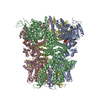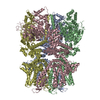[English] 日本語
 Yorodumi
Yorodumi- PDB-9b8z: Cryo-EM structure of the human TRPM4 channel subunit in complex w... -
+ Open data
Open data
- Basic information
Basic information
| Entry | Database: PDB / ID: 9b8z | ||||||||||||||||||||||||||||||
|---|---|---|---|---|---|---|---|---|---|---|---|---|---|---|---|---|---|---|---|---|---|---|---|---|---|---|---|---|---|---|---|
| Title | Cryo-EM structure of the human TRPM4 channel subunit in complex with calcium and decavanadate at 37 degrees Celsius | ||||||||||||||||||||||||||||||
 Components Components | Transient receptor potential cation channel subfamily M member 4 | ||||||||||||||||||||||||||||||
 Keywords Keywords |  TRANSPORT PROTEIN / TRANSPORT PROTEIN /  ion channel / ion channel /  TRP channel TRP channel | ||||||||||||||||||||||||||||||
| Function / homology |  Function and homology information Function and homology informationpositive regulation of atrial cardiac muscle cell action potential / positive regulation of regulation of vascular associated smooth muscle cell membrane depolarization /  sodium channel complex / regulation of T cell cytokine production / membrane depolarization during AV node cell action potential / membrane depolarization during bundle of His cell action potential / membrane depolarization during Purkinje myocyte cell action potential / negative regulation of bone mineralization / ligand-gated calcium channel activity / sodium ion import across plasma membrane ...positive regulation of atrial cardiac muscle cell action potential / positive regulation of regulation of vascular associated smooth muscle cell membrane depolarization / sodium channel complex / regulation of T cell cytokine production / membrane depolarization during AV node cell action potential / membrane depolarization during bundle of His cell action potential / membrane depolarization during Purkinje myocyte cell action potential / negative regulation of bone mineralization / ligand-gated calcium channel activity / sodium ion import across plasma membrane ...positive regulation of atrial cardiac muscle cell action potential / positive regulation of regulation of vascular associated smooth muscle cell membrane depolarization /  sodium channel complex / regulation of T cell cytokine production / membrane depolarization during AV node cell action potential / membrane depolarization during bundle of His cell action potential / membrane depolarization during Purkinje myocyte cell action potential / negative regulation of bone mineralization / ligand-gated calcium channel activity / sodium ion import across plasma membrane / regulation of ventricular cardiac muscle cell action potential / sodium channel complex / regulation of T cell cytokine production / membrane depolarization during AV node cell action potential / membrane depolarization during bundle of His cell action potential / membrane depolarization during Purkinje myocyte cell action potential / negative regulation of bone mineralization / ligand-gated calcium channel activity / sodium ion import across plasma membrane / regulation of ventricular cardiac muscle cell action potential /  sodium channel activity / calcium-activated cation channel activity / inorganic cation transmembrane transport / sodium channel activity / calcium-activated cation channel activity / inorganic cation transmembrane transport /  TRP channels / dendritic cell chemotaxis / cellular response to ATP / positive regulation of heart rate / regulation of heart rate by cardiac conduction / positive regulation of insulin secretion involved in cellular response to glucose stimulus / protein sumoylation / positive regulation of fat cell differentiation / negative regulation of osteoblast differentiation / positive regulation of vasoconstriction / positive regulation of adipose tissue development / calcium-mediated signaling / calcium ion transmembrane transport / Sensory perception of sweet, bitter, and umami (glutamate) taste / positive regulation of canonical Wnt signaling pathway / positive regulation of cytosolic calcium ion concentration / protein homotetramerization / TRP channels / dendritic cell chemotaxis / cellular response to ATP / positive regulation of heart rate / regulation of heart rate by cardiac conduction / positive regulation of insulin secretion involved in cellular response to glucose stimulus / protein sumoylation / positive regulation of fat cell differentiation / negative regulation of osteoblast differentiation / positive regulation of vasoconstriction / positive regulation of adipose tissue development / calcium-mediated signaling / calcium ion transmembrane transport / Sensory perception of sweet, bitter, and umami (glutamate) taste / positive regulation of canonical Wnt signaling pathway / positive regulation of cytosolic calcium ion concentration / protein homotetramerization /  adaptive immune response / adaptive immune response /  calmodulin binding / neuronal cell body / calmodulin binding / neuronal cell body /  calcium ion binding / positive regulation of cell population proliferation / calcium ion binding / positive regulation of cell population proliferation /  Golgi apparatus / Golgi apparatus /  endoplasmic reticulum / endoplasmic reticulum /  nucleoplasm / nucleoplasm /  ATP binding / ATP binding /  membrane / identical protein binding / membrane / identical protein binding /  plasma membrane / plasma membrane /  cytosol cytosolSimilarity search - Function | ||||||||||||||||||||||||||||||
| Biological species |   Homo sapiens (human) Homo sapiens (human) | ||||||||||||||||||||||||||||||
| Method |  ELECTRON MICROSCOPY / ELECTRON MICROSCOPY /  single particle reconstruction / single particle reconstruction /  cryo EM / Resolution: 3.4 Å cryo EM / Resolution: 3.4 Å | ||||||||||||||||||||||||||||||
 Authors Authors | Hu, J. / Lu, W. / Du, J. | ||||||||||||||||||||||||||||||
| Funding support |  United States, 9items United States, 9items
| ||||||||||||||||||||||||||||||
 Citation Citation |  Journal: Nature / Year: 2024 Journal: Nature / Year: 2024Title: Physiological temperature drives TRPM4 ligand recognition and gating. Authors: Jinhong Hu / Sung Jin Park / Tyler Walter / Ian J Orozco / Garrett O'Dea / Xinyu Ye / Juan Du / Wei Lü /  Abstract: Temperature profoundly affects macromolecular function, particularly in proteins with temperature sensitivity. However, its impact is often overlooked in biophysical studies that are typically ...Temperature profoundly affects macromolecular function, particularly in proteins with temperature sensitivity. However, its impact is often overlooked in biophysical studies that are typically performed at non-physiological temperatures, potentially leading to inaccurate mechanistic and pharmacological insights. Here we demonstrate temperature-dependent changes in the structure and function of TRPM4, a temperature-sensitive Ca-activated ion channel. By studying TRPM4 prepared at physiological temperature using single-particle cryo-electron microscopy, we identified a 'warm' conformation that is distinct from those observed at lower temperatures. This conformation is driven by a temperature-dependent Ca-binding site in the intracellular domain, and is essential for TRPM4 function in physiological contexts. We demonstrated that ligands, exemplified by decavanadate (a positive modulator) and ATP (an inhibitor), bind to different locations of TRPM4 at physiological temperatures than at lower temperatures, and that these sites have bona fide functional relevance. We elucidated the TRPM4 gating mechanism by capturing structural snapshots of its different functional states at physiological temperatures, revealing the channel opening that is not observed at lower temperatures. Our study provides an example of temperature-dependent ligand recognition and modulation of an ion channel, underscoring the importance of studying macromolecules at physiological temperatures. It also provides a potential molecular framework for deciphering how thermosensitive TRPM channels perceive temperature changes. | ||||||||||||||||||||||||||||||
| History |
|
- Structure visualization
Structure visualization
| Structure viewer | Molecule:  Molmil Molmil Jmol/JSmol Jmol/JSmol |
|---|
- Downloads & links
Downloads & links
- Download
Download
| PDBx/mmCIF format |  9b8z.cif.gz 9b8z.cif.gz | 184.4 KB | Display |  PDBx/mmCIF format PDBx/mmCIF format |
|---|---|---|---|---|
| PDB format |  pdb9b8z.ent.gz pdb9b8z.ent.gz | 140.5 KB | Display |  PDB format PDB format |
| PDBx/mmJSON format |  9b8z.json.gz 9b8z.json.gz | Tree view |  PDBx/mmJSON format PDBx/mmJSON format | |
| Others |  Other downloads Other downloads |
-Validation report
| Arichive directory |  https://data.pdbj.org/pub/pdb/validation_reports/b8/9b8z https://data.pdbj.org/pub/pdb/validation_reports/b8/9b8z ftp://data.pdbj.org/pub/pdb/validation_reports/b8/9b8z ftp://data.pdbj.org/pub/pdb/validation_reports/b8/9b8z | HTTPS FTP |
|---|
-Related structure data
| Related structure data |  44363MC  9b8wC  9b8xC  9b8yC  9b90C  9b91C  9b92C  9b93C  9b94C M: map data used to model this data C: citing same article ( |
|---|---|
| Similar structure data | Similarity search - Function & homology  F&H Search F&H Search |
- Links
Links
- Assembly
Assembly
| Deposited unit | 
|
|---|---|
| 1 |
|
- Components
Components
| #1: Protein | Mass: 134456.484 Da / Num. of mol.: 1 Source method: isolated from a genetically manipulated source Source: (gene. exp.)   Homo sapiens (human) / Gene: TRPM4, LTRPC4 / Production host: Homo sapiens (human) / Gene: TRPM4, LTRPC4 / Production host:  Mammalia (mammals) / References: UniProt: Q8TD43 Mammalia (mammals) / References: UniProt: Q8TD43 | ||||
|---|---|---|---|---|---|
| #2: Chemical | | #3: Chemical | ChemComp-DVT / |  Sodium decavanadate Sodium decavanadateHas ligand of interest | Y | |
-Experimental details
-Experiment
| Experiment | Method:  ELECTRON MICROSCOPY ELECTRON MICROSCOPY |
|---|---|
| EM experiment | Aggregation state: PARTICLE / 3D reconstruction method:  single particle reconstruction single particle reconstruction |
- Sample preparation
Sample preparation
| Component | Name: human TRPM4 channel subunit in complex with calcium and decavanadate at 37 degrees Celsius Type: COMPLEX / Entity ID: #1 / Source: RECOMBINANT |
|---|---|
| Source (natural) | Organism:   Homo sapiens (human) Homo sapiens (human) |
| Source (recombinant) | Organism:  Mammalia (mammals) Mammalia (mammals) |
| Buffer solution | pH: 8 |
| Specimen | Embedding applied: NO / Shadowing applied: NO / Staining applied : NO / Vitrification applied : NO / Vitrification applied : YES : YES |
Vitrification | Cryogen name: ETHANE |
- Electron microscopy imaging
Electron microscopy imaging
| Experimental equipment |  Model: Titan Krios / Image courtesy: FEI Company |
|---|---|
| Microscopy | Model: FEI TITAN KRIOS |
| Electron gun | Electron source : :  FIELD EMISSION GUN / Accelerating voltage: 300 kV / Illumination mode: FLOOD BEAM FIELD EMISSION GUN / Accelerating voltage: 300 kV / Illumination mode: FLOOD BEAM |
| Electron lens | Mode: BRIGHT FIELD Bright-field microscopy / Nominal defocus max: 1900 nm / Nominal defocus min: 1200 nm Bright-field microscopy / Nominal defocus max: 1900 nm / Nominal defocus min: 1200 nm |
| Image recording | Electron dose: 50 e/Å2 / Film or detector model: GATAN K3 (6k x 4k) |
- Processing
Processing
CTF correction | Type: PHASE FLIPPING AND AMPLITUDE CORRECTION |
|---|---|
3D reconstruction | Resolution: 3.4 Å / Resolution method: FSC 0.143 CUT-OFF / Num. of particles: 243000 / Symmetry type: POINT |
 Movie
Movie Controller
Controller










 PDBj
PDBj



